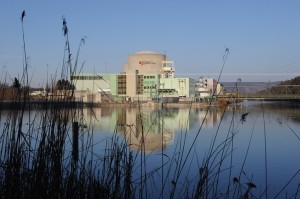“Only an ultrasonic examination is capable of providing authoritative information regarding the current condition of the reactor pressure vessel.”
The Swiss Federal Nuclear Safety Inspectorate (ENSI) requires the Beznau nuclear power plant to provide proof that the reactor pressure vessel is safe. In an interview, Georg Schwarz, the Director of the Division for Nuclear Power Plants and Deputy Director of ENSI, explains the importance of carrying out ultrasonic inspections.
Beznau 2 has also been disconnected from the grid for a week now. What is the current status of the inspections into the reactor pressure vessels of the two units at Beznau?
Georg Schwarz: At Beznau 1, we are waiting for Axpo to submit proof that the reactor pressure vessel is safe. In order to provide this, it will carry out further examinations and will be required to provide proof that any indications ascertained will not affect safety. Only once ENSI is convinced of its safety case, will Beznau 1 be allowed to restart. At Beznau 2, Axpo will also carry out the required ultrasonic examination during the course of the overhaul that is currently taking place.
After the detection of flaw indications in the reactor pressure vessels of the Belgian plants Doel 3 and Tihange 2, the first thing that ENSI did was to examine the manufacturing documents and then demand that a ultrasonic inspection be carried out on the base material involved. Why did you proceed in two stages?
An ultrasonic examination of the reactor pressure vessel at the Mühleberg nuclear power plant, which was produced by the same forge as Doel 3 and Tihange 2, already took place in 2012. In January 2013, ENSI extended the investigations to include all forged reactor pressure vessels. During the first stage, we required all nuclear power plants to examine their manufacturing documentation. By doing this, we wanted to acquire an overview of the situation that exists in Switzerland, as quickly as possible. During a second and much more important stage, the ENSI asked in July 2013 that an ultrasonic examination be carried out on all forged reactor pressure vessels.
In that regard, you were following a recommendation by the Western European Nuclear Regulators Association, WENRA.
Switzerland, which has occupied the Chair of the WENRA since 2011 in the person of Hans Wanner, the Director General of ENSI, strongly advocated carrying out such investigations for all Europe. We would have demanded these ultrasonic inspections in any case, independently from any international recommendation.
How important is it to examine the manufacturing documentation?
Ultrasonic examinations of a reactor pressure vessel are not something that can be organised one day and carried out on the next. Specialist companies must be contracted and the plant must be shut down. In 2013, however, our aim was to acquire an initial overview as rapidly as we could. That is why we required this step. The checking of the manufacturing documentation cannot replace an ultrasonic examination though. It is this type of examination that provides information regarding the current condition of a reactor pressure vessel, thereby enabling its safety to be assessed.
The manufacturing documentation for the reactor pressure vessel in the Beznau 1 plant was incomplete. Is that a problem?
If documents are missing, ENSI always presumes the worst-case scenario. In this particular case, no detailed information regarding the heat-treatment of the forged components of Beznau 1 was available. Without that information, the possibility of any associated forging defects cannot be excluded. Nevertheless, ENSI was able to undertake an initial assessment, even without that documentation. Let me repeat at this point that ENSI not only looked at the documents, but also required additional ultrasonic measurements to be taken. Only an ultrasonic examination is capable of providing authoritative information regarding the current condition of the reactor pressure vessel.
Are ultrasonic examinations of the base material of the reactor pressure vessel also carried out during the lifetime of a nuclear power plant?
Normally, the international standard requires us only to examine the welds at regular intervals. An expansion of the measurements to include the base material was required as a result of the flaws indications detected in Belgium.
When will Beznau 1 generate electricity once again?
The necessary examinations are extremely extensive. According to the current plans, I estimate that we will conclude our safety review in the first quarter of 2016 at the earliest.
And what will happen if Axpo is unable to provide the necessary proof for Beznau 1?
In that case, Beznau 1 will not be allowed to restart.


